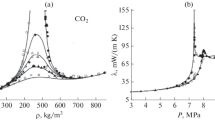Abstract
A pure component is supercritical when its temperature and pressure are above the temperature and pressure of the critical point (CP). In the supercritical domain of the phase diagram, there no longer exists a difference between gaseous and liquid states, and fluids are in an intermediate and somewhat paradoxical state where their thermophysical properties are similar to those of gases for some of them and those of liquids for others. Taking into account the gravity, the diverging compressibility at the CP induces a stable stratification of the fluid density. The stratification is significant, sometimes as much as 10% in a one cm layer. For example, a one cm high cell containing He3 at 3 mK above its critical temperature is equivalent to a 180 m high column of air or a 7 km high column of water in terms of stratification. Therefore, supercritical fluids (SCFs) at the scale of the laboratory share several features with large geophysical systems. This observation has led several authors into suggesting their use as laboratory models for geophysical flows. However, the peculiarity of near-critical systems could make this analogy fail. In the present work, we have investigated the analogy between both kinds of systems (SCFs at small scale and geophysical flows at large ones) through the study of two examples: the onset of convection in a SCF layer subjected to an adverse temperature gradient, and the generation of internal gravity waves in an isothermal SCF layer. In both cases, the use of asymptotic techniques and of stability analysis has shown that the role of the initial stratification was dominant. At the same time, the fluid flow has been shown to be very similar to that of weakly compressible fluids, the peculiar phenomena specific to SCFs being in this case of second order.
Similar content being viewed by others
REFERENCES
A. Onuki, H. Hong, and R. A. Ferrell, Phys. Rev. A 41:2256(1990).
H. Boukari, J. N. Shaumeyer, M. E. Briggs, and R. W. Gammon, Phys. Rev. A 41:2260(1990).
A. Onuki and R. A. Ferrell, Phys. A 164:245(1990).
J. V. Sengers and M. R. Moldover, Space Res. 18 (1978).
R. F. Berg, M. Lyell, G. McFadden, and R. G. Rehm, Phys. Fluids 8:1464(1996).
M. S. Gitterman and V. A. Steinberg, Phys. Met. Metallogr. 34:305(1970).
P. Carlès and B. Ugurtas, Phys. D 126:69(1998).
E. A. Spiegel, Astrophysical Journal 141:1068(1965).
D. Tritton, Physical Fluid Dynamics, 2nd Ed. (Clarendon Press, Oxford, 1988), pp. 176–179.
P. Carlès and L. El Khouri, Phys. Fluids 13:3775(2001).
J. Lighthill, Waves in Fluids (Cambridge University Press, Cambridge, 1978), pp. 285–337.
J. J. Niemla, L. Skrbek, K. Sreenivasan, and R. J. Donnelly, Nature (London) 404 (2000).
X. Chavanne, F. Chilla, B. Chabaud, B. Castaing, and B. Hebral, Phys. Fluids 13:1300(2001).
M. Assenheimer and V. Steinberg, Nature 367:345(1994).
H. Stanley, Introduction to Phase Transitions and Critical Phenomena (Oxford University Press, New York, Oxford, 1971).
S. Chandrasekhar, Hydrodynamic and Hydromagnetic Stability (Clarendon Press, Oxford, 1961), pp. 8–43.
A. Kogan and H. Meyer, Phys. Rev. E 63:056310(2001).
P. Carlès and B. Zappoli, Phys. Fluids 7:2905(1995).
P. Carlès, Phys. D 147:36(2000).
Author information
Authors and Affiliations
Corresponding author
Rights and permissions
About this article
Cite this article
El Khouri, L., Carlès, P. Supercritical Fluids as Experimental Models for Geophysical Flows. International Journal of Thermophysics 24, 683–693 (2003). https://doi.org/10.1023/A:1024084131821
Issue Date:
DOI: https://doi.org/10.1023/A:1024084131821




